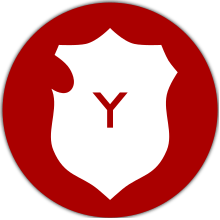201st Independent Infantry Brigade (Home)
The 201st Independent Infantry Brigade (Home) was a short-lived Home Defence formation of the British Army during World War II.
| 201st Independent Infantry Brigade (Home) | |
|---|---|
| Active | 4 October 1940-13 December 1941 |
| Country | |
| Branch | |
| Type | Infantry |
| Role | Home Defence |
| Size | Brigade |
| Insignia | |
| Badge worn when in the Yorkshire County Division |  |
Formation and Service
The 201st Independent Infantry Brigade was formed for service in the United Kingdom on 4 October 1940 by No 1 Infantry Training Group in Aldershot Command. It was commanded by Brigadier A.E. Lawrence, and comprised four newly raised infantry battalions from Southern England.[1] 'Home' brigades had a purely static defence role.[2]
Service
The brigade moved from Aldershot Command to XII Corps on 10 October and then briefly to the West Sussex County Division (on 9 November), then to the Yorkshire Area (Military District) (on 21 February 1941), then to the Yorkshire County Division on 19 March, after that was formed on 24 February.[1][3] The Yorkshire County Division was re-designated the East Riding Coastal Area on 1 December and the brigade went with it until it was disbanded on 13 December.[1]
Order of battle
The composition of 201st Brigade was as follows:[1]
- 13th Battalion, Queen's Royal Regiment (West Surrey) – joined 4 October 1940, left 25 November 1941; later to 211th Bde[4]
- 14th Battalion, Queen's Royal Regiment (West Surrey) – formed 4 July 1940 at Dorchester, Dorset, joined 4 October 1940, left 3 June 1941, converted on 1 December that year into 99th Light Anti-Aircraft Regiment, Royal Artillery[5]
- 9th Battalion, Hampshire Regiment – formed 4 July 1940, joined 4 October 1940, left 5 December 1941 to be converted into 157th Regiment Royal Armoured Corps[6]
- 10th Battalion, Hampshire Regiment – formed 4 July 1940 at Aldershot, joined 4 October 1940, left 25 November 1941 to be converted into 147th Regiment Royal Armoured Corps[6]
Notes
- Joslen, p. 364.
- Joslen, p. 223.
- Joslen, p. 117
- Joslen, p. 374.
- Frederick, pp. 200, 836.
- Frederick, pp. 12–3, 253.
References
- J.B.M. Frederick, Lineage Book of British Land Forces 1660–1978, Vol I, Wakefield: Microform Academic, 1984, ISBN 1-85117-007-3.
- Lt-Col H.F. Joslen, Orders of Battle, United Kingdom and Colonial Formations and Units in the Second World War, 1939–1945, London: HM Stationery Office, 1960/Uckfield: Naval & Military, 2003, ISBN 1843424746.